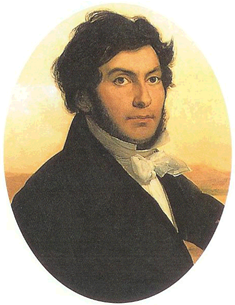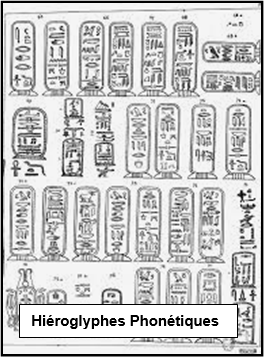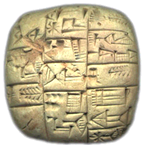


JEAN CHAMPOLLION DECIPHERS THE ROSETTA STONE 1822 (G4)
xxxxxAs we have seen (1798 G3b), the ancient Rosetta Stone, inscribed with a passage in hieroglyphics, was discovered by the French in Egypt in 1799 and confiscated by the British in 1801. A number of scholars attempted to decipher the script, including the English physicist Thomas Young, but it was the French linguist Jean François Champollion (1790-
 xxxxxAs we have seen (1798 G3b), it was in 1799 that a French artillery officer serving in Egypt found a slab of basalt embedded in a wall near the town of Rosetta (now called Rashid) in the Nile delta. Dating from the 2nd century BC, this “Rosetta Stone”, as it came to be called, had inscribed on it a passage of the same text in three versions -
xxxxxAs we have seen (1798 G3b), it was in 1799 that a French artillery officer serving in Egypt found a slab of basalt embedded in a wall near the town of Rosetta (now called Rashid) in the Nile delta. Dating from the 2nd century BC, this “Rosetta Stone”, as it came to be called, had inscribed on it a passage of the same text in three versions -
xxxxxOverxthe next few years two scholars in particular made some progress in deciphering the text (from prints made from the stone’s inscriptions). The Frenchman Silvestre de Sacy (1758-

xxxxxAt the age of 19, Champollion became professor of history at the Lyceum at Grenoble, and it was from this time onwards that he began deciphering hieroglyphics in earnest, making a close study of the text of the Rosetta Stone. It became virtually an obsession, and involved him in long years of work and many frustrations. He was assisted by his sound knowledge of ancient languages, but it was not until 1821, in fact, that he began publishing papers on his findings. However, by the following year, 1822, he had translated all the hieroglyphic signs into their Greek equivalents, having come to realise -
xxxxxIn 1826, on the strength of his discoveries, he was appointed curator of the Egyptian collection at the Louvre and, two years later, led an archaeological expedition to Egypt to copy inscriptions on ancient monuments, and collect antiquities. On his return he was made professor of Egyptian antiquities at the Collège de France, a chair created in his honour, and elected to the French Academy. Sadly, in 1832 he died of a stroke, aged 41, and was buried in the Père Lachaise cemetery in Paris.
xxxxxApart from his Summary of the Hieroglyphic System, written in 1824, he went on to produce a Collection of the Mythological Figures of Ancient Egypt (1823-
xxxxxIncidentally, we are told that when Champollion eventually broke the code, making out the word Rameses, he dashed into his brother’s study and, shouting Je tiens l’affaire! (“I’ve got it!), promptly collapsed. He was confined to his bed for the best part of a week! ……
 xxxxx…… Thexfirst major breakthrough in the deciphering of the wedge-
xxxxx…… Thexfirst major breakthrough in the deciphering of the wedge-
Acknowledgements
Champollion: by the French portrait painter Léon Cogniet (1794-
G4-


